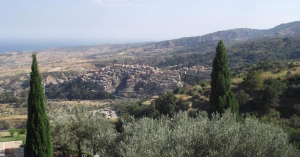 Caro Tito, sai bene come e quanto fin dalla mia prima adolescenza (anni sessanta) mi sia sempre impegnato a favore dei borghi antichi, come Badolato, che si andavano spopolando sempre più rischiando di perdere non soltanto abitanti ma l’identità comunitaria e persino le case, le pietre, il territorio. Della vicenda di “Badolato paese in vendita” (che le nostre stesse nuove generazioni purtroppo, dopo 30 anni, ormai ignorano quasi del tutto) resta almeno una testimonianza storica, se non altro per l’eco che ha avuto in tante parti del mondo. Ma sarebbe utile che tutte le nuove generazioni venissero educate (anche a scuola) a salvare i propri paesi che rischiano veramente di morire.
Caro Tito, sai bene come e quanto fin dalla mia prima adolescenza (anni sessanta) mi sia sempre impegnato a favore dei borghi antichi, come Badolato, che si andavano spopolando sempre più rischiando di perdere non soltanto abitanti ma l’identità comunitaria e persino le case, le pietre, il territorio. Della vicenda di “Badolato paese in vendita” (che le nostre stesse nuove generazioni purtroppo, dopo 30 anni, ormai ignorano quasi del tutto) resta almeno una testimonianza storica, se non altro per l’eco che ha avuto in tante parti del mondo. Ma sarebbe utile che tutte le nuove generazioni venissero educate (anche a scuola) a salvare i propri paesi che rischiano veramente di morire.

Pure a tale scopo, lo scorso anno 2016 ho fondato il MES – Movimento Europeo Salva-borghi con la speranza di sensibilizzare istituzioni, partiti, stampa, associazioni, enti e persone per salvare non soltanto gli antichi borghi ma un’intera civiltà, strategica pure per la salvaguardia dell’ambiente idrogeologico (salvaguardia che i frequenti e assai tragici disastri naturali e sociali dimostrano essere quanto mai fin troppo necessaria ed urgente). Nel medesimo anno 2016, il 13 ottobre a Rimini, è stato presentato in anteprima dalla Regione Emilia-Romagna (che ne è coordinatrice) il progetto nazionale denominato “Borghi – Viaggio italiano” nel contesto del “2017 anno dei borghi” voluto da Dario Franceschini, ministro per i Beni e le Attività Culturali e del Turismo (Mibact). Lo stesso che, nella suggestiva cornice di Castel Sant’Angelo in Roma, lo scorso mercoledì 15 febbraio 2017 ha presentato ufficialmente tale “2017 anno dei borghi” … una promettente iniziativa, limitata però ad un migliaio di antichi paesi italiani disseminati in 18 regioni, tra cui Calabria e Sicilia.
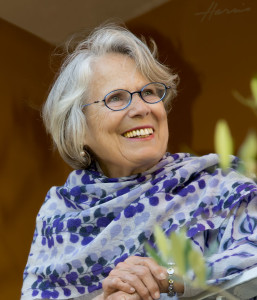 Se ne dovrebbe sapere di più nel sito www.viaggio-italiano.it che al momento risulta essere tanto striminzito quanto unicamente enunciativo persino nei 4,26 minuti del video promozionale https://www.youtube.com/watch?v=ImoOpDfDAJ8 … un “troppo poco” che ha fatto dire a qualcuno che probabilmente si tratta (come al solito) di “aria fritta”. Vedremo quanti e quali risultati concreti avrà espresso alla fine. La presentazione del ministro Franceschini a Castel Sant’Angelo è stata narrata e commentata dalla maggior parte della stampa italiana, ma anche estera. Tra i resoconti esteri, riporto qui di sèguito soltanto il testo dell’interessante articolo della bravissima e meritoria giornalista USA Judith Harris per come ripreso dal sito internet italo-americano http://www.iitaly.org/magazine/focus/op-eds/article/preserving-and-promoting-italys-ancient-borghi. Nella parte conclusiva di tale descrizione è riportato il seguente mio breve commento, accompagnato da una foto panoramica dell’amenissimo borgo medievale di Badolato.
Se ne dovrebbe sapere di più nel sito www.viaggio-italiano.it che al momento risulta essere tanto striminzito quanto unicamente enunciativo persino nei 4,26 minuti del video promozionale https://www.youtube.com/watch?v=ImoOpDfDAJ8 … un “troppo poco” che ha fatto dire a qualcuno che probabilmente si tratta (come al solito) di “aria fritta”. Vedremo quanti e quali risultati concreti avrà espresso alla fine. La presentazione del ministro Franceschini a Castel Sant’Angelo è stata narrata e commentata dalla maggior parte della stampa italiana, ma anche estera. Tra i resoconti esteri, riporto qui di sèguito soltanto il testo dell’interessante articolo della bravissima e meritoria giornalista USA Judith Harris per come ripreso dal sito internet italo-americano http://www.iitaly.org/magazine/focus/op-eds/article/preserving-and-promoting-italys-ancient-borghi. Nella parte conclusiva di tale descrizione è riportato il seguente mio breve commento, accompagnato da una foto panoramica dell’amenissimo borgo medievale di Badolato.
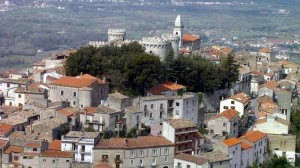
“L’iniziativa del ministro Dario Franceschini è assai lodevole e può essere considerata però soltanto un timido primo passo verso un maggiore impegno verso la salvezza e la valorizzazione dei 15.000 borghi europei spopolati e, quindi, non soltanto italiani. Ma tale grande impegno deve passare necessariamente da una qualificata rappresentanza istituzionale nei parlamenti regionali, nazionali e nel governo dell’Europa e da una nuova filosofia Centro-Periferie e Città-Campagna. Senza questa importante rappresentanza decisionale e senza tale nuova filosofia politica si rischia di fare soltanto folclore, propaganda, demagogia e di dare un’Aspirina ad un malato quasi terminale”.
Preserving and promoting Italy’s ancient borghi (from Judith Harris)
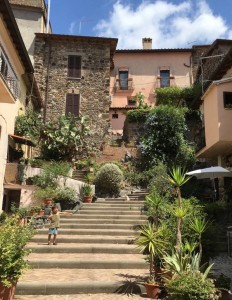 Formally proclaimed this week by Culture Minister Dario Franceschini, 2017 is the official Year of the Borghi, dedicated to promoting and preserving Italy’s 1,000 ancient towns.
Formally proclaimed this week by Culture Minister Dario Franceschini, 2017 is the official Year of the Borghi, dedicated to promoting and preserving Italy’s 1,000 ancient towns.
In the library of the Castel Sant’Angelo in Rome, Culture Minister Dario Franceschini formally proclaimed the year 2017 as the Year of the Borghi, devoted to promoting and preserving Italy’s 1,000 ancient towns. Making the project all the more dramatically and urgent was the destruction of a half dozen of these because of the earthquakes that shook Central Italy last August and September. During the year, said Franceschini, “We will work to make our traditions and the culture of countless marvelous places better known.”
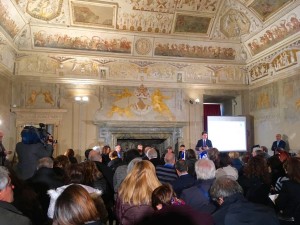 Not by accident, the idea of Italy’s Year of the Borghi coincides with the United Nations designating 2017 as the International Year of Sustainable Tourism for Development, “whose aim is to celebrate and promote the contribution of the tourism sector to building a better world,” said the UN in its January launch. (For details, see: >>>) Both the UN and Italy are urging a change in policies, business practices and consumer behavior so as to advance sustainable tourism and — in the words of the UN — help preserve the environment and foster prosperity, peace and understanding among peoples.
Not by accident, the idea of Italy’s Year of the Borghi coincides with the United Nations designating 2017 as the International Year of Sustainable Tourism for Development, “whose aim is to celebrate and promote the contribution of the tourism sector to building a better world,” said the UN in its January launch. (For details, see: >>>) Both the UN and Italy are urging a change in policies, business practices and consumer behavior so as to advance sustainable tourism and — in the words of the UN — help preserve the environment and foster prosperity, peace and understanding among peoples.
Cultural tourism focuses upon new experiences with depth and is thus considered a crucial factor in maintaining the borghi as centers for hospitality and crafts. In fact, a few small ancient borghi, including one in Tuscany which attracts 15,000 tourists a year, are success stories, both for its inhabitants and for the visitors.
 However, Italian tourism has tended to focus upon a limited areas of the center and north. “Tourism in the borghi exemplifies sustainable tourism. It helps diversify the offer, and hence reduce the pressure on the usual ultra-popular tourist attractions,” said Undersecretary Dorina Bianchi. “It promotes the authentic expression of the Italian way of life — its quality and the rediscovery of a rich artistic and historical heritage.” The borghi can be considered a brand, she added, for a relaunch of the tourism sector.
However, Italian tourism has tended to focus upon a limited areas of the center and north. “Tourism in the borghi exemplifies sustainable tourism. It helps diversify the offer, and hence reduce the pressure on the usual ultra-popular tourist attractions,” said Undersecretary Dorina Bianchi. “It promotes the authentic expression of the Italian way of life — its quality and the rediscovery of a rich artistic and historical heritage.” The borghi can be considered a brand, she added, for a relaunch of the tourism sector.
Why is this necessary? Unless resources are provided to maintain employment in the borghi, their inhabitants risk drifting away. “But jobs can be created,” said Franceschini, “as we know from the inspiring experience of the alberghi diffusi which have brought people, including youth, back to our historic towns.” These
scattered hotels are created by refurbishing abandoned buildings in the center of an historic town, creating a new style of tourism that has brought new life to old borghi. For instance, Santo Stefano di Sessanio, near l’Aquila in the Abruzzo, has had 23 houses restructured by Swedish architect Daniele Kihlgren, who is known as “the man who saves the borghi” (see >>>) Kihlgren also went on to restructure houses at the Sassi di Matera and has acquired five other borghi throughout Italy which, working with the local townships, he plans to restore. Some had been completely abandoned.
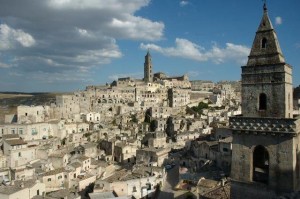 One problem which emerged at the conference: that borgo residents pay the same taxes as those living in large cities, where the maintenance costs are higher. “We need revision of taxation,” said one participant.
One problem which emerged at the conference: that borgo residents pay the same taxes as those living in large cities, where the maintenance costs are higher. “We need revision of taxation,” said one participant.
Italy’s state tourism agency Enit, working with 18 of the Italian regions, is planning promotional events in coming months in the U.S. as well as throughout Europe to stimulate this new brand of international cultural tourism. To this end last year Enit signed a convention with the association “The Most Beautiful Borghi of Italy.”
Domenico Lanciano, who lives in Badolato near Catanzaro, is the founder of the Movimento Europeo Salva-Borghi (MES, Movement to Save European Borghi). For Lanciano, the problem is not solely Italy’s. “This is merely a first step toward saving Europe’s 15,000 uninhabited or under-inhabited ancient borghi,” he said in an interview Thursday. “We need qualified institutional representation in the governments of all the regions and nations and of Europe. We also need a new philosophy concerning the relations between the center and the outlying neighborhood (the periphery) and between city and countryside. Without this decisional representation, without a new political philosophy, the risk is to have only folklore, propaganda, demagogy — an aspirin for the terminally ill.”
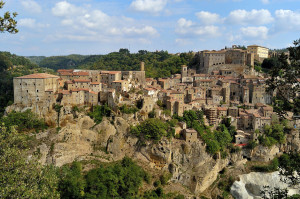 Caro Tito, forse è proprio giunto il momento di fare veramente “rete” tra tutti coloro che sono molto seriamente impegnati nella salvezza e nella valorizzazione nei nostri borghi spopolati, semi-spopolati, morenti e morti. E di realizzare una forza anche politica che (dentro o fuori i partiti tradizionali) possa fare eleggere propri rappresentanti con il principale scopo di intervenire nei centri di comando locali, regionali, nazionali ed europei per salvare più borghi e più territorio possibile. Senza una simile rappresentanza politica dedicata non ci saranno vere prospettive e probabilmente saremo tutti, indistintamente tutti, responsabili del disfacimento non soltanto dei nostri paesi ma anche di mille e più anni di storia e di civiltà costiera, appenninica, padana ed alpina (per limitarci alla sola Italia).
Caro Tito, forse è proprio giunto il momento di fare veramente “rete” tra tutti coloro che sono molto seriamente impegnati nella salvezza e nella valorizzazione nei nostri borghi spopolati, semi-spopolati, morenti e morti. E di realizzare una forza anche politica che (dentro o fuori i partiti tradizionali) possa fare eleggere propri rappresentanti con il principale scopo di intervenire nei centri di comando locali, regionali, nazionali ed europei per salvare più borghi e più territorio possibile. Senza una simile rappresentanza politica dedicata non ci saranno vere prospettive e probabilmente saremo tutti, indistintamente tutti, responsabili del disfacimento non soltanto dei nostri paesi ma anche di mille e più anni di storia e di civiltà costiera, appenninica, padana ed alpina (per limitarci alla sola Italia).
Grazie anche da parte mia per tutto ciò che stai facendo tu per valorizzare i nostri borghi, attraverso questo tuo prezioso sito www.costajonicaweb.it, l’efficace associazione MaryWebEventy, le tue numerose e belle iniziative (tra cui il film “Malaspina … senza pietà”).
Viva i nostri borghi!

Domenico Lanciano Mare del Vasto (Abruzzo),
sabato 18 febbraio 2017 ore 16,51